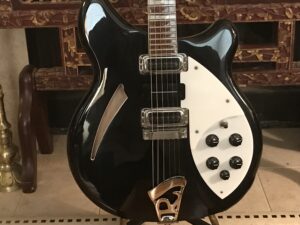
Q: If I install a RunBarr, can I continue to play off of the RunBarr?
A: Of course. Whatever you choose. The RunBarr is a pick-depth regulating OPTION you can choose on-the-fly. You can even play half-a-lick on it, half-a-lick off it. That’s part of the concept/design of the RunBarr. Playing on the RunBarr can train you to play better, faster, cleaner on guitars WITHOUT a RunBarr.
Q: Why didn’t people have RunBarrs a long time ago, if they are as effective as you say?
A: When I went to patent the RunBarr, in 2012, my patent agent said it best: “It took them 30 years to think of putting the striker on the BACK of a matchbook so people wouldn’t set themselves on fire. The RunBarr is like that…”
FAQ’s re: Playing on the RunBarr
Q: Can the RunBarr affect my guitar sound?
A: Yes. It can clean it up. The RunBarr has no metal parts so it’s magnetically transparent. Very little if any, “noise” made upon the RunBarr will be picked up by the pickups on an amplified electric guitar. This is the opposite of what happens with errant noise made upon steel strings; unwanted noise is amplified. Our studies have taught us that imperfections in picking technique result in studio-intolerable noise. Some players turn their picks to a 40 degree angle to gain speed, but the pick scraping the strings is almost as loud through the pickups as the string sound itself. More noise is created when players’ fingernails contact a string accidentally. The RunBarr quite simply, reduces your ability to make these undesirable noises. We think RunBarrs intercept string fumbling and transfer noises onto its non-transducible surface, resulting in overall noise reduction.
We believe that the RunBarr is also a pre-signal path compressor limiter, only with no electronic artifacts. Striking the string at the same height on the pickface every time, has the effect of evening out string volume transmitted through your pickups.
Q: If I install a RunBarr, can I continue to play off of the RunBarr?
A: Of course. Whatever you choose. The RunBarr is a pick-depth regulating OPTION you can choose on-the-fly. You can play half-a-lick on it, half-a-lick off it. That’s part of the concept/design of the RunBarr. Playing on the RunBarr can train you to play better, faster, cleaner WITHOUT a RunBarr.
Q: Will I become permanently dependent on the RunBarr to play chops I can’t play without it?
A: No. You can transfer new skills gained upon the RunBarr, to guitars (and any other plectrum-based instrument!) without RunBarrs on them, over time. The key lies in building muscle-memory from large numbers of successful string strikes which trains in success, speed, and flow to your picking. No two players are exactly alike! Stay with the RunBarr, and you will start to see fantastic results. Your picking hand WILL UNLEARN stumbling, missed strings and other mishaps that plague most guitar pickers. At that point you can kill it on any guitar (including acoustic guitar!) because the RunBarr will cause your muscles-memory to “forget how to fail” on a pickstroke. Consistent, even picking depth is a stepping stone to the all-important “forget how to fail” syndrome we seek.
Q:What’s the best thing a player in early stages of development can do with the RunBarr?
A: Work your single-note tremelo. Get it going, then without interruption sail off into a lick once the tremelo is up to speed. Speedpick, shred out accordingly.
Q: My picking hand is suddenly faster than my fretting hand. How can my fretting hand catch up?
A: In all likelihood your fretting hand will catch up, if for no other reason than a pickstroke is binary motion, and fingering is the equivalent of dual-core binary motion. Pick must travel down-up twice to accomodate a 4 note run, yet your fretting fingers have four shots at the string in the same time-span. Mathematically its pretty simple. In any case, you can also increase fretting-finger speed with the drills in the videos. If you are beginning to develop fingertip control while moving your pick through the “strike zone” you are fast as lightning by now! capo up and try open strings drills
Q: You speak of tremelo speed a lot. Why?
A: All flatpicking, speedpicking etc. descends from its ancestor, “tremelo” picking. What most people overlook is that the ancients may have had it right; the very term “tremelo” shares the same root as the term “trembling”. This can be thought of as an almost involuntary micromotion at a speed higher than the concious mind can necessarily account for. We seek to harness that speed and the runbarr gets it done for you.
Its also worth noting, whether you swoop in from a distance in your picking amplitude (like SRV) or Micromanage your amplitude towards economy of motion (like Malmsteen), it all comes down to the point of attack. In some sense, how you choose to get to the point of attack is your business, my business is to make it work when you get there.
Q: Why is it that when picking 16th notes in flat-out tremelo, my comfort zone starts at a high number of bpm then goes up?
A: Your inborn, optimum trem speed is essentially unique to you, and generally, very fast indeed.
Q: What about the RunBarr and rythm guitar
A: Sure, strum on it. But it’s main benefit is, for example: If I’m covering both lead and rythm guitar, switching back and forth in the same song without the RuBarr is very problematic because I cannot pick lead “freehand”, i.e., I can’t use my strum motion to pick lead without the RunBarr.
Q: Do you always perform with your RunBarr?
A: I always perform with the RunBarr on electric guitar. It’s my personal preference since there’s no possible downside. It’s easily removed, so it’s your choice.